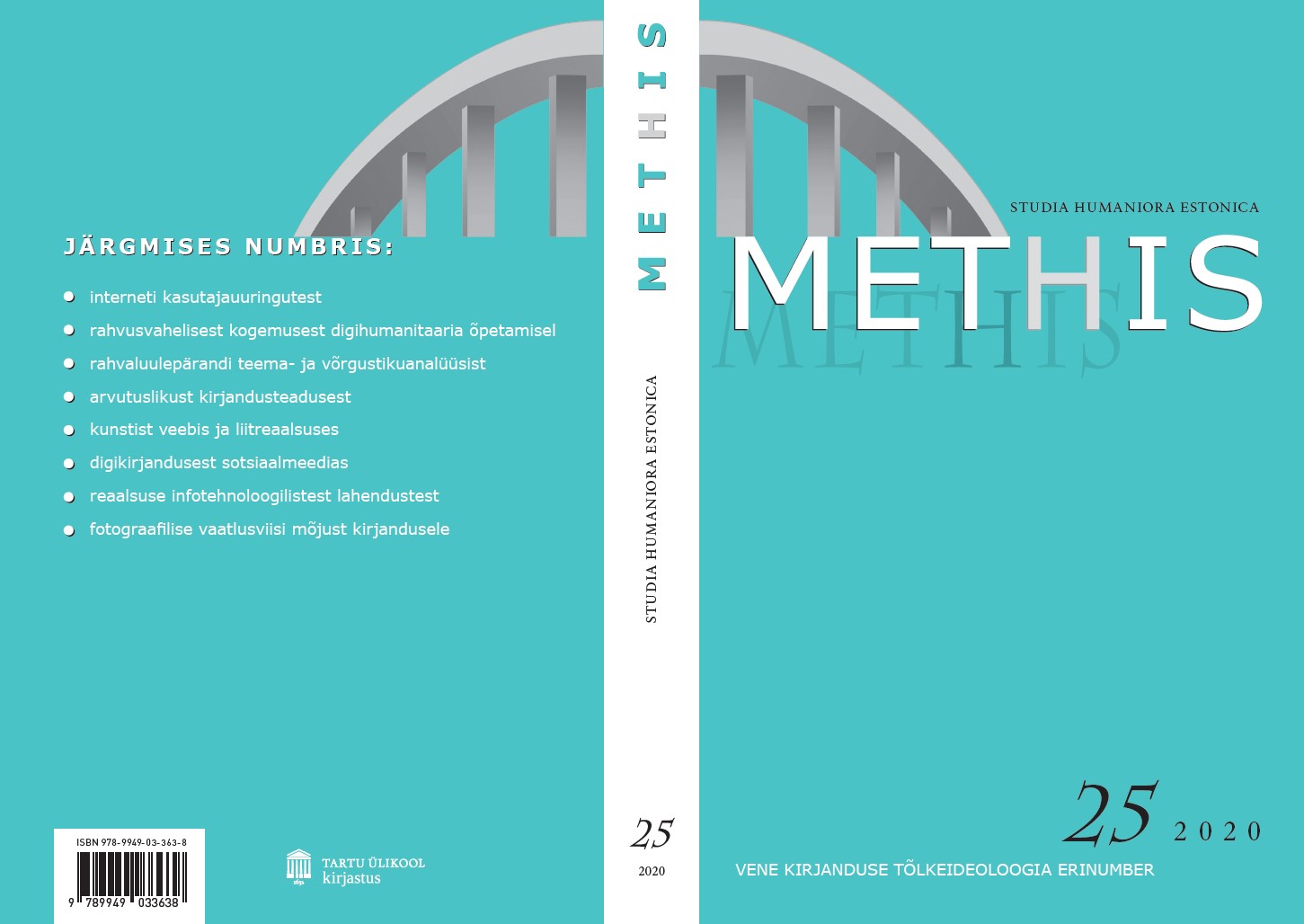Draamateoste tõlkimise teooria ja reaalsus Anton Tšehhovi näidendi „Kirsiaed“ mõnede tõlgete analüüsi näitel / Translation theory and reality: The case of multiple translations of Chekhov’s The Cherry Orchard into German
DOI:
https://doi.org/10.7592/methis.v20i25.16570Keywords:
tõlketeooria, draamatekstide tõlge, Anton Tšehhov, „Kirsiaed“, translation theory, translation of dramatic works, Anton Chekhov, Cherry OrchardAbstract
Artiklis võrreldakse Vera Bischitzky, Rudolf Noelte, Thomas Braschi, ja Hans Polli Tšehhovi „Kirsiaia“ tõlkeid. Püstitatakse küsimus lavatõlke iseärasustest: selguse, häälduse mugavuse, süntaksi lihtsuse nõue. Mõnikord kasutatakse tõlgetes adaptsiooni, püüdes selgitada või eemaldada vaatajale arusaamatuid tekstielemente. Erisuguseid tõlkestrateegiaid illustreeritakse konkreetsete näidetega. Lahatakse vaadeldavate tekstide tõlkeprobleeme: idioomid, reaalid, mitteekvivalentne leksika, ja osutatakse tehtud tõlkeotsustele. Järeldatakse, et vaatamata laialdasele teoreetilisele tõlkealasele kirjandusele, mis soovitab rangelt hoida lahus „kirjandusliku ja lavatõlke“, on reaalsuses kõik põimunud, ning nn kirjanduslikud tõlked võivad vabalt kõlada (ja kõlavadki) lavalaudadel.
The article compares several translations of Chekhov’s comedy The Cherry Orchard into German. The translations discussed are made by Peter Urban, Vera Bischitzky, Rudolf Noelte, Thomas Brasch, and Hans Poll. The general theoretical question is raised whether special translations are required for the theatre: for example, if requirements such as clarity, easy pronouncability and simplicity of syntax, all together known as “scenicity”, are crucial in drama translation. The article demonstrates different translation strategies.
The difficulties in translating the play can be summed up as follows: Chekhov creates speech peculiarities of each character of his play, depending on his or her social milieu, education, and individual characteristics. How to preserve these in translation? The language of the play contains indicators of its time (obsolete words and expressions). Does the translation need to render these? Transferring the realities of time and place is a task almost always facing the translator who, in this case, must choose the degree of modernity of the play’s language. The same applies to the translation of proverbs, sayings and quotes, as well as proper names, patronymics, diminutives like Dunyasha, etc. as foreign readers and audiences need not know that names such as Avdotya Fedorovna and Dunyasha can denote the same person, etc. How to treat citations, puns, jokes? Again, each translator resolves this issue in their own way.
The translation by Rudolf Noelte, made for a radio play, borders on an adaptation: Nölte shortens the text noticeably; eliminates any references to realia such as kvas, Kharkov, Yaroslavl; rejects all patronymics, so that Lyubov Andreyevna becomes Frau Ranewskaya; erases nicknames and many meaningful or stylistically important expressions or even whole remarks from the text. He uses modern language. The translation of Peter Urban implies knowledge from the German audience that it need not have – for example, the awareness that Varya and Varvara Mikhailovna are the same person. Urban uses transliteration of realia, such as the name of the drink “kvas” or the address mamochka (‘mummy’). The translation is close to the original text, it is suitable for reading, but need not be understood by German theatre audiences as a lot of things may remain incomprehensible if this text is delivered on stage. Nevertheless, in the tradition of German translation criticism Chekhov’s texts in Urban’s translations are considered easily pronouncable, simple and clear, and are especially popular with stage directors. A similar approach to Chekhov’s text characterises Hans Walter Poll’s translation – just like Urban, he retains the realia, Russian toponyms, etc. The translation by Vera Bischitzky is even closer to Chekhov’s original than those of Urban and Poll. The translator strictly adheres to the principles of extreme accuracy and fidelity to the source and does not leave out or change anything; she usually opts for obsolete words and expressions typical of Chekhov’s time and uncommon today. It seems that she strictly follows the requirements for a “documentary translation”. She also explains words and names in comments. Her translation is even more readable than those by her predecessors and pursues not only literary, but also cultural and educational goals. From the point of view of scenicity, the best option of all the translations examined is that of Thomas Brasch. Almost without reducing or distorting the text, Brasch brings the original language closer to the modern audience by his use of vocabulary and colloquial syntax, and imitating dialogues. His sentences are shorter than those in Urban’ translation, and he often uses a nominative style to make the text clearer to the spectators.
It is generally not known whether translators who translate “close to the text” of the original and provide comments on places unclear for the recipient always realise for what kind of audience their text is intended. It can be assumed that, translating the text of a play, they always have a theatrical production in mind. There is no information whether the translations by Bischitzky have been staged, but it is known that not only the translations of Brasch, who actually wrote for the stage, but also those by Urban and Poll have been recognised by stage directors. Noelte’s translation, that was intended for the stage, is more of an adaptation than a translation, and Brasch’s work is perhaps the only one among those considered that can be called a translation of Chekhov’s text made directly for the stage.
It can be concluded that, despite the extensive theoretical literature on translation that proposes a strict separation between the types of “literary translation” and “stage translation”, in real life everything is intertwined, and literary translations, such as the work by Urban or Poll, can be staged as well. Chekhov’s dramatic works are intended not only for being embodied on stage, but also for reading. The translator’s comments accompanying the text are valuable and contribute to the readers’ comprehension of it.


